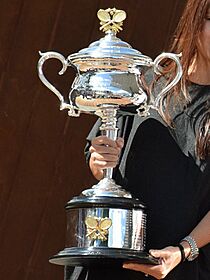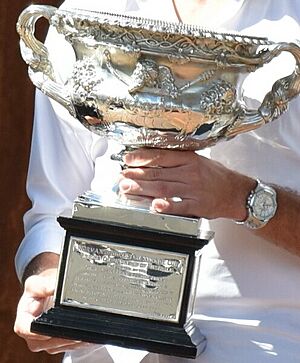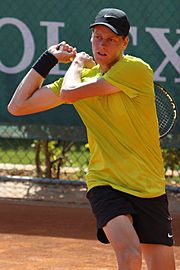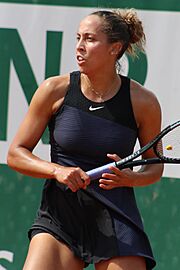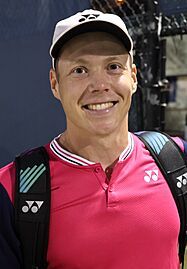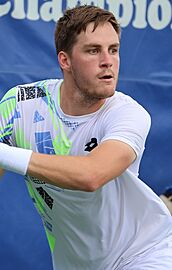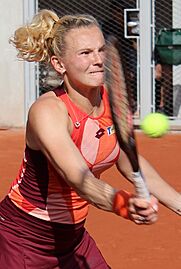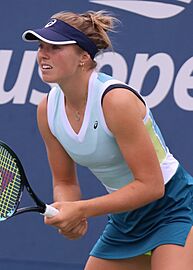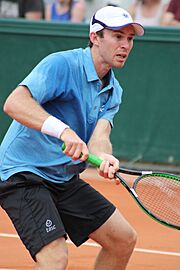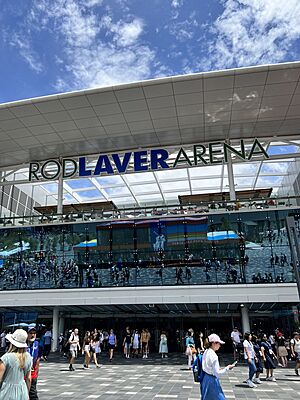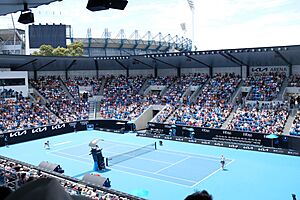Australian Open facts for kids
 |
|
| Official website: http://ausopen.com/ | |
| Founded | 1905 |
|---|---|
| Editions | 113 (2025) 113 Grand Slam events |
| Location | Melbourne CBD Australia |
| Venue | Melbourne Park |
| Surface | Hard – outdoors (since 1988) Grass – outdoors (1905–1987) |
| Prize money | A$96,500,000 (2025) |
| Men's | |
| Draw | 128S (128Q) / 64D (16Q) |
| Current champions | Jannik Sinner (singles) Harri Heliövaara Henry Patten (doubles) |
| Most singles titles | Novak Djokovic (10) |
| Most doubles titles | Adrian Quist (10) |
| Women's | |
| Draw | 128S (128Q) / 64D (16Q) |
| Current champions | Madison Keys (singles) Kateřina Siniaková Taylor Townsend (doubles) |
| Most singles titles | Margaret Court (11) |
| Most doubles titles | Thelma Coyne Long (12) |
| Mixed doubles | |
| Draw | 32 |
| Current champions | Olivia Gadecki John Peers |
| Most titles (male) | 4 Harry Hopman |
| Most titles (female) | 4 Thelma Coyne Long |
| Grand Slam | |
|
|
| Last completed | |
| 2025 Australian Open | |
The Australian Open is a huge tennis tournament held every year in Melbourne, Australia. It's the very first of the four major tennis events called Grand Slams. The others are the French Open, Wimbledon, and the US Open.
This exciting tournament usually kicks off in mid-January and lasts for two weeks. It features many different types of matches. You can watch men's and women's singles, doubles, and mixed doubles. There are also championships for junior players, wheelchair tennis, and even special events for tennis legends.
The Australian Open was first played on grass courts. But in 1988, it switched to hardcourts. Since then, it has used different types of blue hardcourts. The tournament is often called "the happy slam" because of its fun atmosphere. It's also the most popular Grand Slam, with over 1.2 million people attending the 2025 tournament! It was the first Grand Slam to have retractable roofs on its main courts. This means players can keep playing even if it rains or gets too hot.
Contents
History of the Australian Open
The Australian Open is run by Tennis Australia. It first started way back in November 1905. Back then, it was called the Australasian Championships. It was played on a grass court in Melbourne.
The tournament changed its name to the Australian Championships in 1927. Then, in 1969, it became the Australian Open. Since 1905, it has been held 110 times. Most of these were in Melbourne, but it also took place in other Australian cities like Sydney, Adelaide, Brisbane, and Perth. It even visited two cities in New Zealand: Christchurch and Hastings.
For a long time, not many players from other countries came to the tournament. This was because Australia is so far away. In the 1920s, a boat trip from Europe to Australia took about 45 days! Even within Australia, it was hard for players to travel. For example, when the tournament was in Perth, players from the east coast often couldn't make the long train journey.
During World War I (1916–1918) and World War II (1941–1945), the tournament was not held. In 1972, it was decided that Melbourne would be the permanent home for the tournament. This was because Melbourne attracted the most fans. The tournament was played at the Kooyong Lawn Tennis Club until 1988. Then, it moved to the new Flinders Park complex.
The move to Flinders Park was a huge success. The new facilities were much bigger and better. In 1988, attendance jumped by 90% compared to the year before! This move also meant a change from grass courts to hard courts. The first hard court surface used was called Rebound Ace.
The Open Era Begins
In 1969, the Australian Open became "open" to all players. This included professional players who weren't allowed to play in major tournaments before. However, for many years, some of the best players still missed the Australian Open. This was because it was so far away, the dates were often around Christmas and New Year, and the prize money was low.
In 1983, famous players like Ivan Lendl, John McEnroe, and Mats Wilander finally came to the tournament. Wilander even won the singles title that year. After this, the tennis authorities decided that the Kooyong stadium was too small. So, in 1988, the tournament moved to Flinders Park, which was later renamed Melbourne Park. This new venue also brought the change from grass to hard courts.
Mats Wilander is the only player to win the tournament on both grass and hard courts. In 2008, the Rebound Ace surface was replaced with a new one called Plexicushion Prestige. This new surface was more consistent and didn't get as hot. In 2020, the courts changed again to a GreenSet surface.
The tournament dates have changed a few times over the years. For example, there was no tournament in 1986. This was because they moved the event from mid-December to mid-January. Since 1987, the Australian Open has mostly stayed in January. In 2021, it was moved to February because of the COVID-19 pandemic.
Melbourne Park Upgrades
Over the years, Melbourne Park has had many upgrades. These improvements made things better for both players and fans. For example, a retractable roof was added to Margaret Court Arena. This made the Australian Open the first Grand Slam to have three main courts with roofs. This means matches can continue no matter the weather!
The player facilities and spectator areas were also improved. The tournament area even expanded into a nearby park called Birrarung Marr. A new major show court, called Kia Arena, opened in late 2021. It can seat 5,000 people.
In December 2018, the Australian Open started using special tie-breaks in the final sets of matches. If the score reaches 6-6 in the final set, players now play a tie-break to 10 points.
In 2021, the tournament used electronic line judging for all matches. This meant no human line judges were needed. It was the first Grand Slam to do this!
Starting in 2024, the Australian Open began on a Sunday, one day earlier than usual. This change helped make sure matches didn't finish too late at night. In 2025, the Australian Open even hosted a pickleball tournament for the first time!
Courts at Melbourne Park
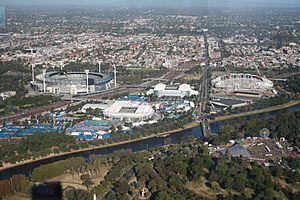
The Australian Open is played at Melbourne Park. This area is part of a larger sports and entertainment hub in Melbourne. Three of the main courts have retractable roofs. This is great for playing during rain or extreme heat. There are also many other courts for matches and practice.
The courts used to be Rebound Ace, then Plexicushion. Since 2020, they have used a GreenSet surface.
Main Courts
Prize Money and Trophies
The Australian Open offers a lot of prize money! The total prize money for the 2025 tournament was A$96.5 million. The winners of the men's and women's singles events receive the same amount.
| Event | W | F | SF | QF | 4R | 3R | 2R | 1R | Q3 | Q2 | Q1 |
| Singles | A$3,500,000 | A$1,900,000 | A$1,100,000 | A$665,000 | A$420,000 | A$290,000 | A$200,000 | A$132,000 | A$72,000 | A$49,000 | A$35,000 |
| Doubles | A$810,000 | A$440,000 | A$250,000 | A$142,000 | A$82,000 | A$58,000 | A$40,000 | N/A | N/A | N/A | N/A |
| Mixed doubles | A$175,000 | A$97,750 | A$52,500 | A$27,750 | A$14,000 | A$7,250 | N/A | N/A | N/A | N/A |
- Doubles prize money is per team.
Trophies
The names of the champions are carved onto special trophy cups. These cups are made by a company called W. J. Sanders and take over 250 hours to create!
- The woman who wins the singles tournament gets the Daphne Akhurst Memorial Cup.
- The man who wins the singles tournament gets the Norman Brookes Challenge Cup.
Champions
Past Champions
You can find lists of all the past champions here:
- Men's singles
- Women's singles
- Men's doubles
- Women's doubles
- Mixed doubles
- All champions
Current Champions
|
Most Recent Finals
| 2025 Event | Champion | Runner-up | Score |
|---|---|---|---|
| Men's singles | 6–3, 7–6(7–4), 6–3 | ||
| Women's singles | 6–3, 2–6, 7–5 | ||
| Men's doubles | 6–7(16-18), 7–6(7-5), 6–3 | ||
| Women's doubles | 6–2, 6–7(4–7), 6–3 | ||
| Mixed doubles | 3–6, 6–4, [10–6] |
Tournament Records
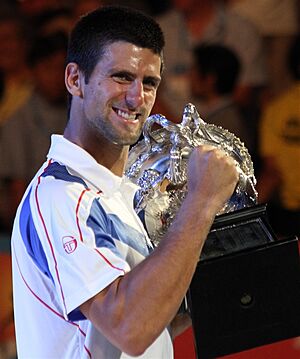
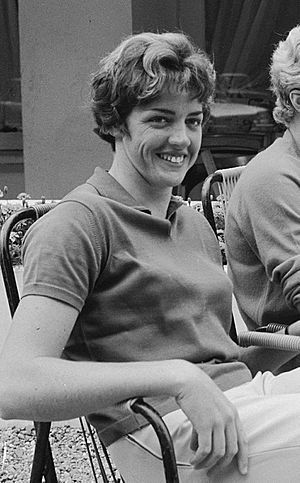
Here are some amazing records from the Australian Open:
| Record | Era | Player(s) | Count | Years | |
|---|---|---|---|---|---|
| Men since 1905 | |||||
| Most singles titles | Open Era | 10 | 2008, 2011–2013, 2015–2016, 2019–2021, 2023 | ||
| Amateur Era | 6 | 1961, 1963–1967 | |||
| Most consecutive singles titles | Open Era | 3 | 2011–2013, 2019–2021 | ||
| Amateur Era | 5 | 1963–1967 | |||
| Most doubles titles | Open Era | 6 | 2006–2007, 2009–2011, 2013 |
||
| Amateur Era | 10 | 1936–1940, 1946–1950 | |||
| Most consecutive doubles titles | Open Era | 3 | 2009–2011 |
||
| Amateur Era | 10 | 1936–1940, 1946–1950 | |||
| Most mixed doubles titles | Open Era | 3 | 1988–1990 2003, 2010, 2015 2007, 2011, 2014 |
||
| Amateur Era | 4 | 1930, 1936–1937, 1939 1940, 1946–1948 |
|||
| Most Championships (singles, doubles, mixed doubles) |
Open Era | 10 | 2008–2023 (10 men's singles) | ||
| Amateur Era | 13 | 1936–1950 (3 singles, 10 men's doubles, 0 mixed doubles) | |||
| Women since 1922 | |||||
| Most singles titles | All-time | 11 | 1960–1966, 1969–1971, 1973 | ||
| Open Era | 7 | 2003, 2005, 2007, 2009, 2010, 2015, 2017 | |||
| Amateur Era | 7 | 1960–1966 | |||
| Most consecutive singles titles | Open Era | 3 | 1969–1971 1974–1976 1988–1990 1991–1993 1997–1999 |
||
| Amateur Era | 7 | 1960–1966 | |||
| Most doubles titles | Amateur Era | 12 | 1936–1940, 1947–1949, 1951–1952, 1956, 1958 | ||
| Open Era | 8 | 1980, 1982–1985, 1987–1989 | |||
| Most consecutive doubles titles | Open Era | 7 | 1982–1985, 1987–1989 |
||
| Amateur Era | 5 | 1936–1940 |
|||
| Most mixed doubles titles | Open Era | 3 | 2019–2021 | ||
| Amateur Era | 4 | 1924–1925, 1928–1929 1930, 1936–1937, 1939 1940, 1946–1948 1951–1952, 1954–1955 |
|||
| Most Championships (singles, doubles, mixed doubles) |
All-time | 23 | 1960–1973 (11 singles, 8 women's doubles, 4 mixed doubles) | ||
| Open Era | 12 | 1980–2003 (3 singles, 8 women's doubles, 1 mixed doubles) | |||
| Amateur Era | 20 | 1936–1952 (6 singles, 10 women's doubles, 4 mixed doubles) | |||
| Wheelchair: singles since 2002, doubles since 2004, quads since 2008 | |||||
| Most singles titles | Men | 11 | 2007–2011, 2013–2015, 2018, 2020, 2022 | ||
| Women | 9 | 2002–2004, 2006–2009, 2011–2012 | |||
| Quads | 7 | 2015–2021 | |||
| Most consecutive singles titles | Men | 5 | 2007–2011 | ||
| Women | 4 | 2006–2009 2021–2024 |
|||
| Quads | 7 | 2015–2021 | |||
| Most doubles titles | Men | 8 | 2007–2011, 2013–2015 | ||
| Women | 7 | 2003–2004, 2006–2009, 2011–2012 2010, 2013, 2017, 2019, 2021–2023 |
|||
| Quads | 9 | 2008–2010, 2013–2017, 2022 | |||
| Most consecutive doubles titles | Men | 5 | 2007–2011 | ||
| Women | 4 | 2006–2009 2021–2024 |
|||
| Quads | 5 | 2013–2017 | |||
| Other Records | |||||
| Unseeded champions | Men | 1976 | |||
| Women | 1978 2007 |
||||
| Youngest singles champion | Men | 18 years and 2 months (1953) | |||
| Women | 16 years and 4 months (1997) | ||||
| Oldest singles champion | Men | 37 years and 2 months (1972) | |||
| Women | 35 years and 8 months (1954) | ||||
Watching the Australian Open
The Australian Open is shown on TV all around the world. In Australia, the Nine Network broadcasts the tournament. In Europe, you can watch it on Eurosport. In the United States, ESPN2 and ESPN show the matches. Many other countries also have their own broadcasters.
How Many People Attend?
The Australian Open is the most attended Grand Slam tournament. The 2025 tournament set a new record with over 1.2 million people attending! The record for a single day was 97,132 people on January 17, 2025.
Here's how many people have attended the tournament each year since it moved to Melbourne Park:
- 2025: 1,218,831
- 2024: 1,110,657
- 2023: 902,312
- 2022: 346,468
- 2021: 130,374
- 2020: 812,174
- 2019: 796,435
- 2018: 743,667
- 2017: 728,763
- 2016: 720,363
- 2015: 703,899
- 2014: 643,280
- 2013: 684,457
- 2012: 686,006
- 2011: 651,127
- 2010: 653,860
- 2009: 603,160
- 2008: 605,735
- 2007: 554,858
- 2006: 550,550
- 2005: 543,873
- 2004: 521,691
- 2003: 512,225
- 2002: 518,248
- 2001: 543,834
- 2000: 501,251
- 1999: 473,296
- 1998: 434,807
- 1997: 391,504
- 1996: 389,598
- 1995: 311,678
- 1994: 332,926
- 1993: 322,074
- 1992: 329,034
- 1991: 305,048
- 1990: 312,000
- 1989: 289,023
- 1988: 244,859
- 1987: 140,089
See also
 In Spanish: Abierto de Australia para niños
In Spanish: Abierto de Australia para niños
- Australian Open extreme heat policy
- Australian Open series
- Lists of champions
- List of Australian Open champions (all events)
- List of Australian Open men's singles champions
- List of Australian Open women's singles champions
- List of Australian Open men's doubles champions
- List of Australian Open women's doubles champions
- List of Australian Open mixed doubles champions
- List of Australian Open singles finalists during the Open Era, records and statistics
- Other Grand Slam tournaments









